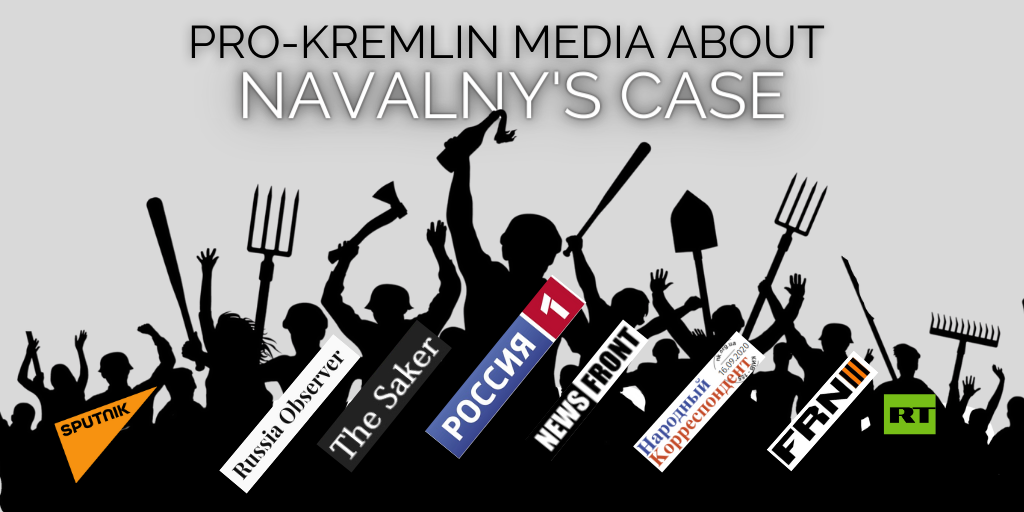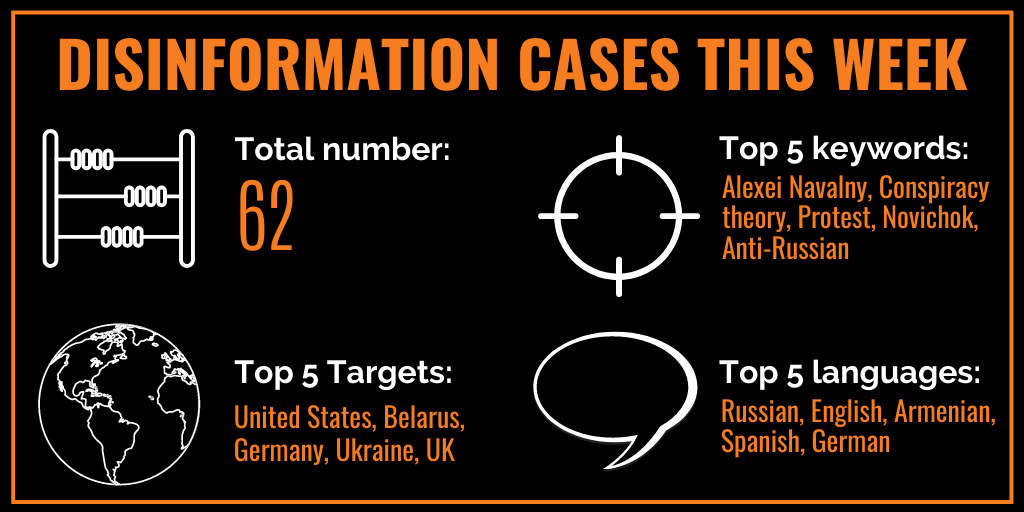
This week’s flow of disinformation demonstrates a continuation of one of the weirdest “lines of defence” for the claim that Russian authorities have nothing to explain in the case of the poisoning of Alexei Navalny, the prominent Russian dissident and anti-corruption activist: “Russia knows better ways to kill him”. Crimea-based News Front’s Spanish edition lines up a few alternatives:
A butter knife, a gun, a speeding car, a traffic accident…
Sarcasm, irony, “humour” is frequently exploited as a means of disinformation. The method was used in the Skripal case and it is used here. Some pro-Kremlin pundits, most of them residing in the West, generously offer their expertise:
- An expert in the US suggests potassium chloride or a car crash
- A UK expert advises a bullet to his head or an actually deadly poison
- An Italian professor recommends delaying hospitalisation or assassinating him in Germany
- A bone saw would be the preferred instrument of a pilot in Switzerland
It is actually surprising that we haven’t documented suggestions to drop a piano on the victim or put Navalny in a tank full of sharks. MI6, after all, is involved! We all know the tricks from the James Bond movies! Or why not an ice-pick, as in the case of late Leon Trotsky, attacked on Kremlin orders on 20 August 1940, exactly 80 years before the poisoning of Alexei Navalny.
The Russian Mission in the EU has issued a statement, suggesting that “there are questions”. In the statement, the Russian diplomats question why Russian state operatives would kill such an irrelevant figure as Navalny:
What would be the reason for the Russian authorities to poison Alexey Navalny, taking into account that his actual popularity level hardly reaches 2%?
It is hard to see how Navalny’s “popularity level” is relevant in an investigation to a violent crime. Yet the figure, referred to by the Representation, can be disputed. A survey from the Levada institute June 2020 finds Mr. Navalny as the second most inspirational figure in the Russian public sphere; incumbent president Vladimir Putin topping the list. In the age group 25 – 39, Putin and Navalny share the lead and in the age group 40 – 54, Navalny outshines Putin.

EU Expecting Investigation
The EU has been very clear that we expect the Russian Government to conduct an urgent transparent investigation in full cooperation with the OPCW. All questions should be addressed and answers given within the proper process and timeline of the investigation, not through public exchanges of “questionnaires”.
The military grade toxic substance used for attacking Navalny was detected by a German laboratory 2 September. The analysis has since been corroborated independently by laboratories in France and Sweden. As the substance used in the attack is forbidden in international law, the case has been referred by the German authorities to the Organisation for the Prohibition of Chemical Weapons, OCPW.
The Deep State Goes Staat im Staate
Last week, the Disinformation Review demonstrated the similarities in the storytelling of the Skripal and the Navalny Cases. The trend continues this week. “Demonising Putin”, “Western Geopolitical Ambitions”, “The Victim’s Own Fault”, “Russophobia”… Several outlets connect the Navalny case with Nord Stream 2, hinting that the poisoning of Mr Navalny is part of an internal German political debate, where a mythical German Deep State is attacking Chancellor Angela Merkel.
The second dominating topic this week is, of course, the situation in Belarus. As in the Navalny case, most stories are based on comfortable old tropes. In the pro-Kremlin universe, protests are always organised by puppet-masters abroad. Pro-Kremlin outlets suggest a few culprits, and how to deal with those orchestrating the protests against Lukashenka:
Externally inspired protests sponsored by the EU, NATO, or even the Jews – Soros or Bernard Levy – should be “appeased” by force.
The Kremlin’s catalogue of foreign malefactors is rarely updated: Lithuania, Poland, the UK, the US… all have, in the world view of pro-Kremlin outlets, the means, the methods and the ambition to manipulate the perfectly peaceful and prosperous Belarus. The pro-Kremlin media refuses to accept the idea of the people as an active subject, and insist that outside forces have brought Belarus to the verge of civil war. So far, the only window broken during several weeks of protest was crashed by an officer of the Police in Minsk. And the Lukashenka regime has brought foreign strike-breakers and even protesters from abroad to imitate support.
Digital Fingerprints
This week also offers a chance to study a blatant piece of forgery: a fake letter from the Vice-President of the European Commission Margaritis Schinas. According to the bogus letter, the EU plans to establish camps for “Arab Migrants” in Georgia. The falsification was almost immediately intercepted and de-bunked, but a few outlets reproduced the claim nevertheless. EUvsDisinfo will return to the topic to demonstrate how the forged letter was injected in the information flow and the tracks the forgers left.
At the time of writing, Mr. Navalny has greeted his followers on Instagram from the Charité Hospital in Berlin. Meanwhile, Russian state controlled media continue attempts to suggest Western involvement in the attack on the Russian dissident.





